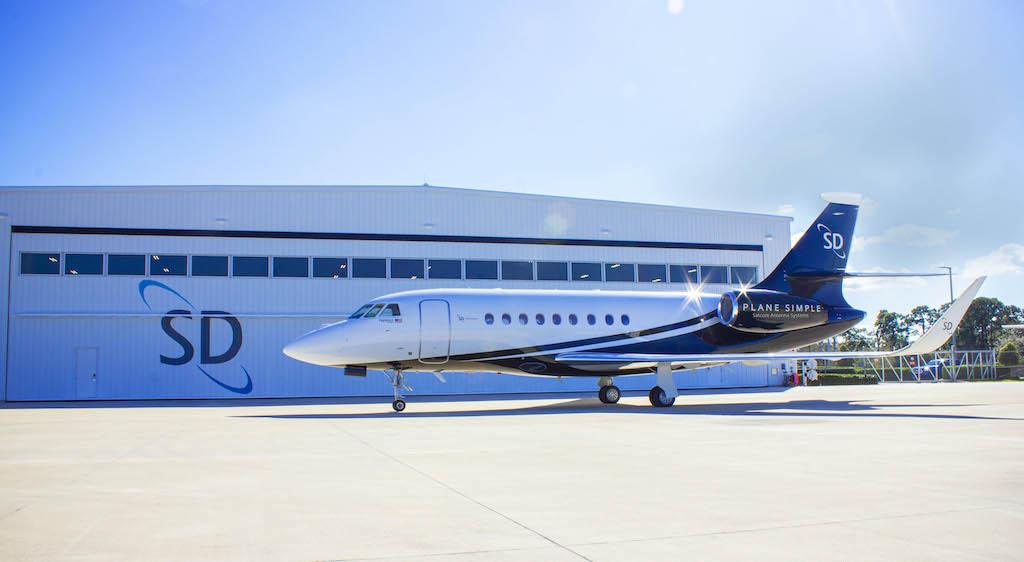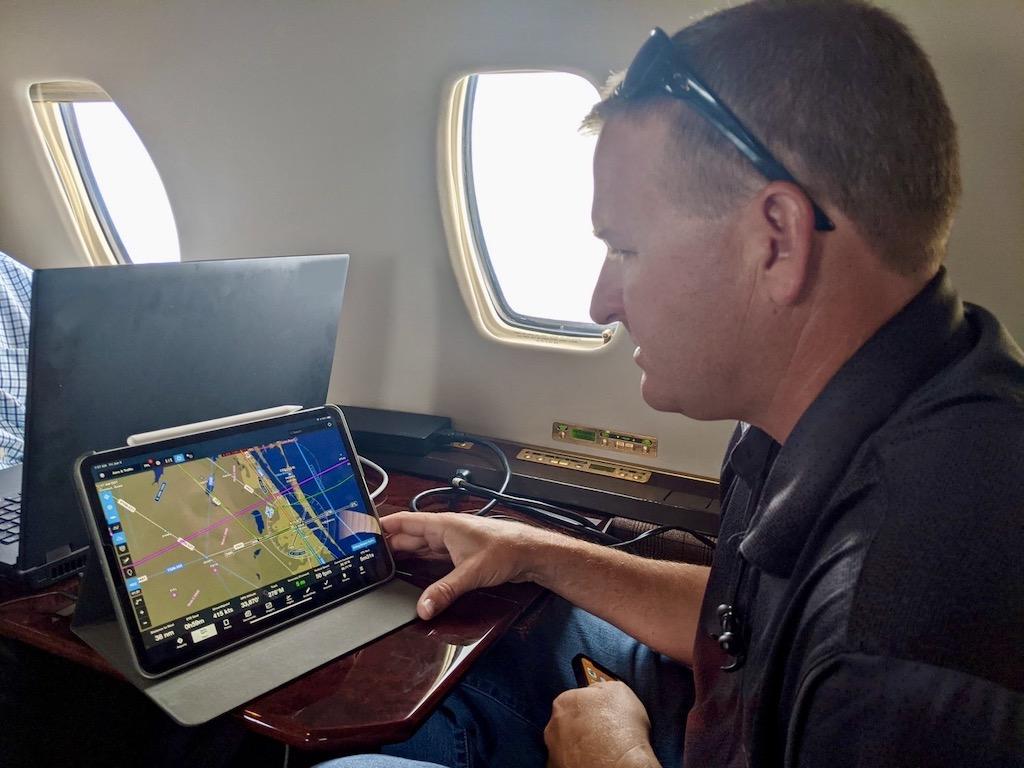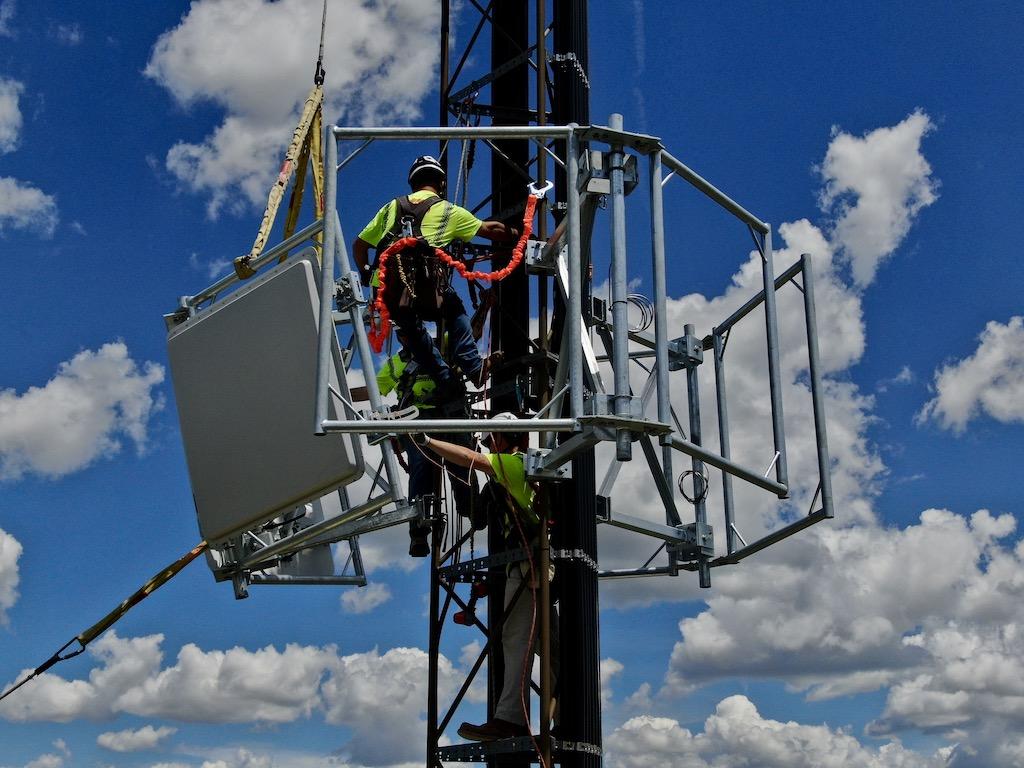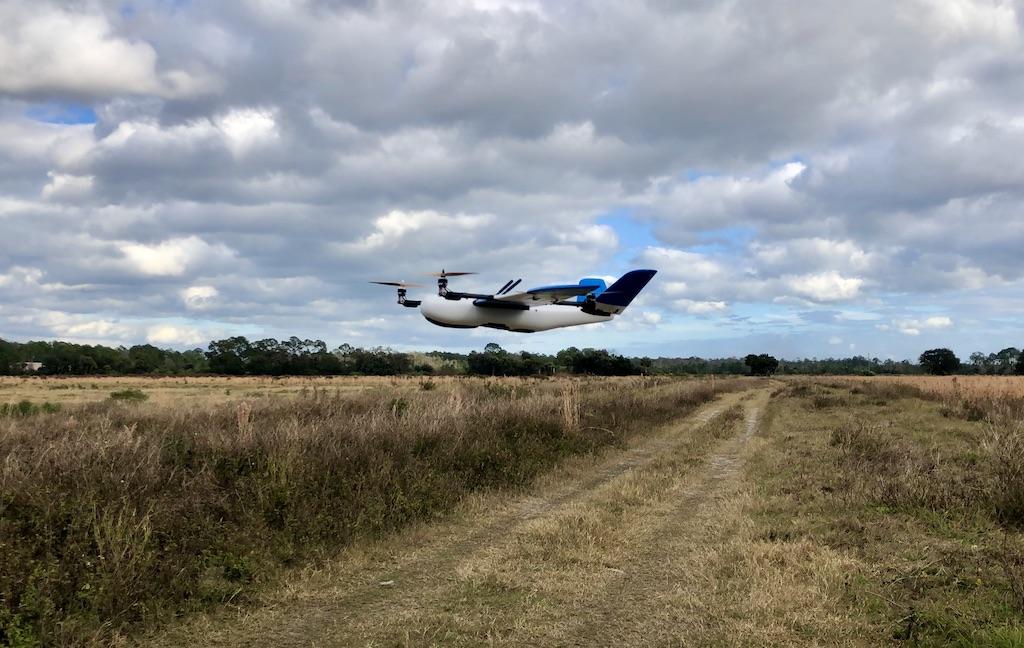
Suppliers of new airborne equipment and networks for air-to-ground and satellite communications have reported progress toward deploying their systems. The status of new in-flight connectivity programs, and an agreement between telecommunications giant Verizon and the FAA to develop cellular connectivity for drones, are summarized below.
Plane Simple Antenna Installation
Satcom Direct (SD) has installed its Plane Simple Ku-band tail-mount antenna on a company Dassault Falcon 2000LX, the second aircraft type fitted with the new satellite communications (satcom) antenna.
SD has already fitted the antenna on a company Gulfstream G350, where it has performed “beyond expectation” in facilitating broadband connectivity during more than 100 flights. The addition of the Dassault Falcon to the validation process will double testing capacity and support supplemental type certification of the installation on the 2000LX.
Installation of the Plane Simple dual-variant antenna is taking place at the Dassault Falcon Jet facility in Little Rock, Arkansas, SD said in June. Flight testing begins in July, with in-service customer evaluations expected to start in the third quarter.
The Plane Simple Ku-band antenna is the first in a series of antenna systems SD is developing with partner QEST Quantenelektronische Systeme of Germany. Once activated, the satcom terminal will support Intelsat’s FlexExec Ku-band service, which has been designed specifically for business aviation operators.
“Adding a second platform will serve to further verify the benefits of integrating the new advanced technology antenna with the already proven SD ecosystem of hardware, software and terrestrial infrastructure,” said Chris Moore, SD president of business aviation. “Our mission is to analyze the performance and deliver a powerful, reliable, validated, connectivity solution to our early adopter customers.”
SD, based in Melbourne, Florida, is the master distributor of FlexExec. It is also an Inmarsat distribution partner, Iridium service partner and Viasat preferred reseller.
https://marketplace.aviationweek.com/company/satcom-direct
Honeywell, SmartSky Expand Agreement

SmartSky Networks has selected Honeywell as an authorized value-added reseller (VAR) of its air-to-ground (ATG) connectivity service for business aviation operators in North America. Announced on June 22, the agreement expands on the companies’ relationship, which began in 2019 when SmartSky named Honeywell a VAR for the commercial aviation market.
SmartSky is deploying an ATG network using 4G LTE and 5G wireless technology and 60 MHz of unlicensed spectrum to provide a low-latency, bidirectional data link to aircraft. The system provides Honeywell customers with another option for high-speed in-flight connectivity. The avionics manufacturer is also a VAR for Inmarsat’s GX Aviation satcom service and supplies JetWave hardware that connects to the Ka-band system.
Honeywell’s GoDirect Router will be authorized for use on the SmartSky Network for business aviation customers who choose the full complement of Honeywell services and support.
“Honeywell Aerospace has been a trusted commercial aviation partner to SmartSky,” said SmartSky CEO David Helfgott. “Expanding our relationship to include business aviation marks yet another important milestone and expands our ability to address this underserved market. Honeywell’s proven track record in providing innovative connectivity and flight services aligns well with SmartSky’s vision to enable and empower the emerging connected aircraft ecosystem.”
https://marketplace.aviationweek.com/company/smartsky-networks
Gogo 5G Progress Update

Gogo Business Aviation on June 22 announced that it has completed several key milestones in developing its new 5G air-to-ground (ATG) network, data center, software and onboard equipment.
Gogo, based in Broomfield, Colorado, is building a 5G network for aircraft operating within the contiguous U.S. It expects the nationwide network will be available in the second half of 2022.
The company said it has installed the first two 5G antennas on a cellular tower in the midwest U.S., allowing it to conduct prototype testing of system performance. It has completed development of 5G air card prototypes and coast-to-coast flight testing of 5G belly-mounted antennas. It has successfully established a connection between the 5G antennas on the aircraft and the 5G antennas on the ground tower.
Gogo has performed an end-to-end call using a 5G SIM card, from the onboard equipment to the cell site, through a data center to the internet, and back.
The company’s Avance L5 4G system for light-to-large business jets and L3 system for turboprops and light jets are now installed and flying on 2,000 business aircraft, Gogo said June 21. L5 systems are compatible with the new 5G network.
“Gogo 5G will be the fourth ATG nationwide network Gogo has designed and built,” said Dave Glenn, Gogo senior v-p of customer operations. “Deploying this first ground site antenna and leveraging our unparalleled ATG experience over 28 years will enable us to validate our design for a smooth product and service launch.”
https://marketplace.aviationweek.com/company/gogo-llc
Cellular-Connected Drones

Verizon Skyward and the FAA have signed a memorandum of agreement to test cellular-connected drones, Skyward announced on June 24. Cellular connectivity will support drone flights beyond visual line of sight (BVLOS) of a remote pilot, unmanned aircraft systems traffic management (UTM) and “one-to-many” operations, the company said.
The three-year agreement allows the parties to mutually research the capabilities of cellular communications networks for command and control (C2) of drones within the national airspace system. Partially focused on safety-critical C2 data, the agreement also allows the parties to propose standards, including for BVLOS operations and for using commercial wireless spectrum. Skyward and parent company Verizon will use the data collected to inform discussions on C2 and BVLOS operations on the FAA’s BVLOS Aviation Rulemaking Committee.
“Cellular-connected drones play a critical role in enabling tomorrow’s safe, reliable, and secure drone operations,” said Matt Fanelli, Skyward director of strategy and operations. “We are thrilled to be laying this foundation with the FAA and are confident that our efforts will help inform technical standards from which industry regulations authorizing low-risk BVLOS and one-to-many operations will flow.”
https://marketplace.aviationweek.com/company/skyward





